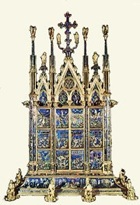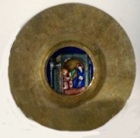The goldsmith Ugolino di Vieri was first documented in his native Siena in 1329. He is best known for the Reliquary of the Sacro Corporale (1337-8) in the Cappella del Corporale of the Duomo, Orvieto (see below).
Orvieto
Reliquary of the Sacro Corporale (1337-8)
This magnificent silver gilt and enamel reliquary now stands in a case in the aedicule to the left of the entrance to
the Cappella del Corporale in the Duomo. The inscription states that Bishop
Beltramo Monaldeschi, the Archpriest Angelo, the papapl chaplain Ligo and a number of named canons of the Duomo commissioned it from “
magistrum Ugolinum et socios, Aurifices de Senis” (Ugolino di Vieri and associates, goldsmiths of Siena) in 1338, during the pontificate of Pope
Benedict XII. It was probably manufactured in Siena, and associated payments are documented in the period 1337-9. This reliquary, which is one of the largest ever commissioned from Siena, was probably the work of a number of “associates” under the direction of Ugolino. It housed the
Sacro Corporale and was taken in procession for the first time on the feast of Corpus Domini of 1338.
The double-sided reliquary replicates the arrangement of the facade of the Duomo. The eight enamels in the upper and middle registers of the shutters on the front constitute the earliest surviving narrative depiction of the Miracle of Bolsena and formed the basis for future representations, including the frescoes of this subject in this chapel (see below). The other four enamels on the front and the twelve enamels on the back depict scenes from the Passion, and those around the base depict scenes from the early life of Christ.
Reliquary of St Sabinus (ca. 1340)
This magnificent reliquary, which contained the skull of of
St Sabinus of Canosa, bears the inscription “
Vgolinus et Yiva de Senis fecierunt istum tabernaculum” (Ugolino di Vieri and
Viva di Lando have made this tabernacle). It was originally in
San Giovenale: this church is referred to as SS Giovenale e Sabino in a document of 1314. The chapel to the left of the apse was dedicated as the Cappella di San Sabino, and other relics of the saint are said to rest under the tufa altar. The parish priest of San Giovenale sold the reliquary to the Opera del Duomo in 1845, and it is now in the
Museo dell' Opera del Duomo.
The cranium of the saint is housed under the cupola above the hexagonal base of the reliquary. Three golden figures adorn the higher registers::
-
✴the Madonna and Child stand above the cupola;
-
✴St Sabinus stands in the register above it; and
-
✴an angel at the top, which was added in the second half of the 19th century to replace an earlier figure.
The six enamels in the base depict scenes from the life of St Sabinus.
Perugia
Gilded silver paten (mid 14th century)
This paten, which has an enamel of the Annunciation at its centre, was rediscovered under the floor of the choir of
San Domenico in 1954, when it was moved to the
Galleria Nazionale. It might have been the paten recorded in the sacristy in the inventories of 1430 and 1458, together with an accompanying chalice (which was subsequently lost) that had been inscribed with the signatures of Ugolino di Vieri and
Viva di Lando.
Read more:
G. Freni, “The Reliquary of the Holy Corporal in the Cathedral of Orvieto: Patronage and Politics”, in
J. Cannon and B. Williamson (Eds), “Art, Politics and Civic Religion in Central Italy, 1261-1352”, (2000) Aldershot, pp 117-78
Return to Art in: Orvieto Perugia.
Return to “Foreign” Sculptors in Umbria.






